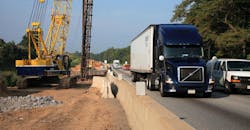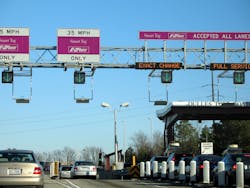Workforce development training, more tolling included in Trump's infrastructure vision
President Trump sent his long-awaited infrastructure funding outline to Congress on Feb. 12. The 55-page document leaves most funding decisions to lawmakers, but calls for the creation of legislation that will “stimulate at least $1.5 trillion in new investment over 10 years.”
Besides recommending expanded tolling and ramping up privatization of rest areas, it also seeks significant changes to existing workforce development programs.
“An infrastructure bill will generate new projects that directly increase employment in the construction industry, as well as boost the demand for labor more broadly as additional infrastructure investment spurs economic growth,” the White House said.
U.S. Labor Secretary Alex Acosta said last year apprenticeships should be part of the strategy for combatting a shortage of truck drivers. American Trucking Associations has established a workforce development subcommittee to study how to attract more drivers and technicians.
The White House outline calls for allowing Pell Grants be used to fund short-term programs that lead to a credential or certification in an in-demand field “where there are shortages of qualified workers." Funding should be used to promote and expand apprenticeships, as well as to “fast-track programs that prepare high school graduates for jobs rebuilding America’s infrastructure,” the White House said.
As for the overall funding plan, the White House said that states and localities are best equipped to understand investment needs, and should “receive incentives in the form of grants.”
The White House also wants greater flexibility to toll existing interstates.
“Tolling restrictions foreclose what might otherwise serve as a major source of revenue for infrastructure investment,” the White House said.
It also wants to provide states greater flexibility to commercialize interstate rest areas, establish a deadline of 21 months for agencies to complete environmental reviews, create a rural infrastructure program, and develop a transformative projects program.
Reactions to the White House proposal were swift.
Chris Spear, president and CEO of ATA, said the plan "unfortunately falls short of the president’s campaign promise to go big and bold, because it lacks the required federal investment. A proposal that relies on fake funding schemes like highway tolls and privatizing rest areas will not generate the revenue necessary to make significant infrastructure improvements."
Before the plan was released, promoted the group's "Build America Fund" during an interview with Fox Business. A key piece of that plan is a federal fuel usage fee built into the price of wholesale transportation fuels collected at the terminal rack, phased in at a nickel per year over four years.
“The Trump administration’s infrastructure plan is choosing Wall Street over Main Street. Tolls will take money from hardworking Americans and give huge profits to toll road investors – many of which are foreign companies,” said Stephanie Kane, spokesperson for the Alliance for Toll-Free Interstates.
Lisa Mullings, president of CEO of NATSO, said rest-area commercialization “allows the government to hand-pick one company to operate exclusively at the state rest areas; this company behaves as a monopoly simply by virtue of its location on the highway shoulder or median.”
Patrick Jones, executive director of the International Bridge, Tunnel and Turnpike Association, said his group applauds “the administration’s proposal to give states flexibility to toll interstate highways to help rebuild them. While tolling is not appropriate in every circumstance, it is a proven tool that speeds project delivery and provides a steady stream of funding for future road maintenance and improvements."
Stephen Sandherr, CEO of the Associated General Contractors of America, had a more cautious reaction.
“The most significant aspect of today's release is that it signals the start of what should be a timely, bipartisan and bicameral process to identify the best ways to fund and finance desperately needed improvements to our public infrastructure,” he said.
That feeling was shared by Bud Wright, executive director of AASHTO, who said the plan “can be a starting point for a robust conversation on how best to make the critical investments in surface transportation.”






